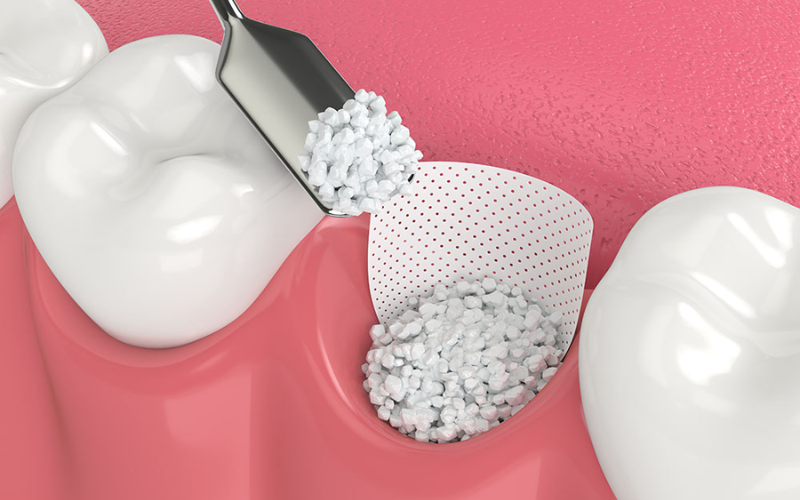
Bone grafting is a common dental procedure used to rebuild and restore bone in areas where tooth loss has occurred. Whether it’s part of a larger dental plan for implants or to support overall oral health, knowing what to expect during the bone grafting healing process is crucial for a successful recovery.
Here’s a week-by-week guide to help you understand what to expect and how to manage your recovery effectively.
Strong Smiles Start with Smart Healing—Don’t Skip The Aftercare
Week 1: Initial Healing Phase – The First Few Days
In the first week after your bone grafting procedure, your body begins to heal the surgical site. Expect some discomfort, swelling, and bruising, but these symptoms should start to subside in a few days.
What To Expect?
- Swelling: It’s normal to have swelling around the surgical site.
- Pain and Discomfort: Mild to moderate pain is typical, often managed with prescribed pain medication.
- Bleeding: A little bleeding may occur within the first 24 hours, but it should stop by day 3.
What You Can Do:
- Apply a cold compress to reduce swelling.
- Follow all post-operative care instructions carefully, especially those related to eating and drinking.
- Avoid smoking and strenuous activities, as they can interfere with the healing process.
Week 2: Reduction in Pain and Swelling
By the second week of bone grafting, most of the initial pain and swelling should start to decrease. At this point, your body is working to promote blood flow and healing to the grafted area.
What To Expect?
- Less Swelling: Most of the swelling should be reduced, although minor swelling may still occur.
- Healing Progress: The bone graft is starting to integrate with your natural bone.
- Slight Discomfort: While discomfort should be significantly reduced, there may still be some tenderness around the graft site.
What You Can Do:
- Continue to follow a soft-food diet and avoid putting pressure on the surgical site.
- Maintain good oral hygiene, but avoid brushing directly on the grafted area.
Week 3: Bone Integration Begins
Around the third week, the bone grafting material is beginning to integrate with your existing bone structure, a process called “osseointegration.”
What To Expect?
- Initial Bone Healing: Your body is working to fuse the graft with your natural bone. At this point, your bone graft is still very much a work in progress, but it’s becoming more stable.
- Some Mild Discomfort: You may still feel mild discomfort, but it should be less frequent and less intense.
What You Can Do:
- Gentle Oral Care: You can begin brushing your teeth normally, but avoid disturbing the surgical area. Use a gentle brush and consider a saltwater rinse to promote healing.
- Follow-up Appointment: A dentist will likely schedule a follow-up appointment to monitor your healing and ensure everything is progressing well.
Week 4: Stable Recovery and New Bone Formation
By week 4, your bone graft is becoming more stable as new bone begins to form around the graft material. You may start to feel much more comfortable during this phase.
What To Expect?
- Better Comfort: Most patients feel significantly less pain at this stage.
- New Bone Formation: Your bone is integrating and healing, and you may begin to feel more confident in your recovery.
What You Can Do:
- Continue following our dentist’s aftercare instructions, including eating soft foods and avoiding any hard or crunchy foods that could disturb the area.
- Gentle Exercise: If the dentist gives the okay, you can begin to resume light activities, avoiding any strenuous exercise.
Week 6: Full Recovery in Sight
By the 6th week, the graft should be stable enough to start progressing toward the next phase of your dental treatment, whether that’s implant placement or another procedure.
What To Expect?
- Pain-Free: The area should now be completely pain-free. Any lingering swelling or discomfort should be minimal or completely gone.
- Bone Healing Complete: By now, the bone graft should be well on its way to full integration with your existing bone.
What You Can Do:
- You can generally resume your normal diet and activities, although it’s still a good idea to be cautious with hard foods near the grafted area.
- Keep up with any follow-up appointments for progress checks.
According to a study published by the Journal of Periodontology, approximately 95% of bone grafts successfully integrate with existing bone over a 6-month period, highlighting the importance of proper care during bone grafting healing.
Ensure a Successful Recovery
Bone grafting healing takes time and care. By following our dentist’s advice and monitoring your healing, you’ll support a strong, healthy smile. If anything feels off during recovery, contact our dentist right away—early care makes all the difference.

